Best heated motorcycle kit | You'll wish you made the switch to electrically heated gear years ago
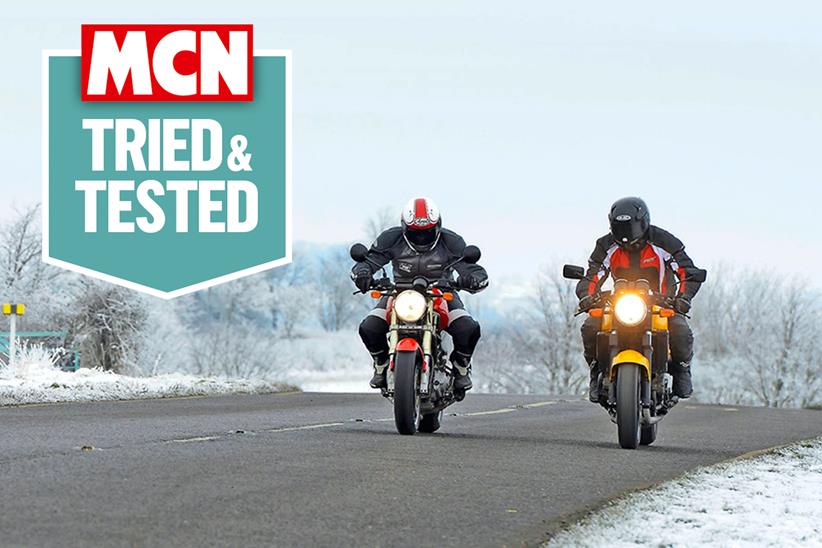
Winter riding can be a daunting experience if you aren’t prepared for it, but nothing is more effective at battling the cold than heated motorcycle kit. Whether you commute year-round with the bike or just enjoy your ride more when the roads are quieter, heated motorcycle kit will significantly improve your comfort and safety when riding in cold or wet weather.
Heated motorcycle kit uses tiny electronic heating elements woven into the garment that heat up, providing a layer of warmth between you and the outside world that’s thinner and more effective than thermal kit. They require a source of electricity, and do come at a price premium, but if nothing short of the best winter kit will do, heated motorcycle kit is what to go for.
Read on to find everything you need to know, and our favourites on the market right now.
Jump to:
- What to consider before buying
- Heated gloves
- Heated vests
- Heated grips
- Heated seats
- How MCN tests kit
What to consider before buying
Battery vs cable power
Some heated kit is battery operated, while others connect with a cable to your bike’s battery, and some can do both. Consider the styles of riding you do in winter, as battery operated kit can be more convenient to ride with, but cable operated kit will never need charging up.
Heat levels
Most heated kit comes with multiple heat settings available, so consider how much range of warmth you’re after. You can never really be sure how much heat is on offer based on specs alone, so it’s best to read some expert reviews first to get an idea how hot they get before buying.
Power draw
You may want to consider how much electricity the heated kit you’re looking at will use when it’s switched on. If you have other electrical accessories attached to your bike, this will help you to check that adding some heated kit to the mix won’t overload your bike’s battery. Or, if your heated kit will be powered by separate batteries, you can work out roughly how long they should last.
Materials and construction
As with any other piece of bike kit, make sure the heated kit you buy has been made to a high standard of quality. Look for quality materials that will stand up to the test of time, and If it’s meant to be worn as an outer layer it should be CE certified. Pay extra close attention to the seams too, as CE certified garments should be double-stitched.
Heated gloves
When the wind-chill effect is at its strongest, the first part of your body to start going numb is usually your fingers, and there’s no better remedy than heated gloves. They’re one of the most popular choices for heated kit, as they really can elevate the riding experience from unbearably cold to downright pleasant.
To stop focusing on the cold and start focusing on the magnificent winter views, here are the best heated gloves we’ve tested:
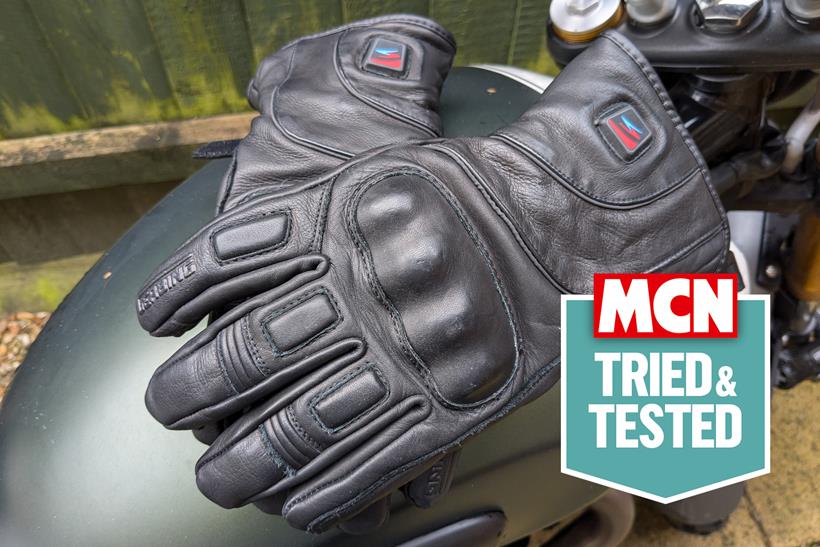

"Wired gloves (that draw their power from the bike's battery) aren't for everyone. Running the cable through your jacket can be fiddly and annoying, if your bike's battery is a pain to reach than fitting the cables can take time and having to remember to switch them back on if you switch your bike off can be frustrating.
"But I'm willing to look beyond all of this in return for the heat performance of these gloves from Gerbing. They're so hot that they come with the highest two settings locked and you have to deliberately unlock them before you can take advantage.
"There's nothing I've used that's as warm without burning my skin and they're uncomfortably hot if the weather isn't cold enough. I had to actually turn them down in 3°C conditions because my hands were getting sweaty."
On the downside, it's a bit annoying that the control button is placed such that it is hidden under your jacket cuff and I'd like a slightly longer power cable but the supplied one just works."
Full Gerbing Xtreme XR review coming soon...
Pros
- Warmest gloves I've ever used
- No need to charge batteries as run off bike
Cons
- Control button placement is slightly inconvenient
| Construction | Leather with Thinsulate lining |
| Type | Heated gloves (wired) |
| CE level | 1 KP |
| Armour | Hard knuckle |
- Waterproof
- Soft armour at wrist and fingers
- Visor wipe
- Short cuff


"The heating system excels in keeping your digits toasty and frost free, but as it’s battery powered does need some planning and management for the best results. If you’re using them to commute, the best advice would be to stick them on charge whenever possible to keep them topped up, or purchase a couple of additional power packs as back ups.
"The Paragon 6 is waterproof, warm and has handy features like the twin visor wipes, plus a price tag that shouldn’t make you wince. All in all, an effective and good value heated winter glove."
Read our full RST Paragon 6 Heated Gloves review
Pros
- Retain warmth well, and without sacrificing too much tactility
- Waterproof membrane proved totally effective under testing
- Dual visor wipes are a rare and welcome feature
- Fingertips and thumb are touch screen friendly
- Heating mechanism is easy to operate
Cons
- The battery packs are a bit bulky, and won’t fit under some sleeves
- Make sure you're getting the newer ones with USB-C rechargeable batteries - the old ones had an issue with charger compatibility
| Construction | Leather and nylon |
| CE Rating | 1 KP |
| Armour | Hard knuckle |
| Waterproof | Yes - SinAqua membrane |
| Visor wipe | Yes - dual |
| Power source | Battery only |
- Soft feel polyester lining
- Sinaqua waterproof membrane
- Hard knuckle protection
- Left index finger visor wipe
- Pre-curved fingers for comfort
- Motion panel for ease of movement
- Smart touch index fingers
- Padded palm and fingers
- Reflective design detail for improved visibility
- Hook and loop wrist adjustment
- Drawcord cuff adjusters
- Rubber control button with 3 settings: High [60°C] Medium [50°C] Low [40°C]
- Approx 4 hours run time on lowest setting, Highest setting up to 2.5 hours
- Battery charge time: approx 3 hours
- Supplied with 2 x 7.4V lithium polymer batteries
- USB C charging cable


"I’d struggle to ride in winter without heated gloves, and the Richa Inferno set are the warmest I’ve ever sampled, making them perfect for those really cold days in the saddle. Sure, there are a few niggles such as unlocking the hottest setting, the bulky batteries and the cost, but I have to admit that it’s forgiven when the heat is turned up to the max.
"Without batteries the Infernos fit nice and snug and feel secure when on, and they offer a reasonable amount of protection too, thanks to D30 armour, Cordura 600D textile and goatskin reinforcement."
Read our full Richa Inferno review
Pros
- Tight, secure feeling closure
- Lots of warmth on tap - the hottest setting really is hot
- Proved completely waterproof under testing
Cons
- Batteries not included, and they're quite bulky as far as batteries go
- Having to unlock the hottest setting is an annoyance while riding
| Construction | Cordura 600D textile |
| CE Rating | 1 |
| Armour | D3O knuckle protector and temperfoam palm slider |
| Waterproof | Yes - Hipora membrane |
| Visor wipe | Yes |
| Power source | Wired - optional batteries available |
- AquaShell LTZ waterproof and breathable membrane
- Superfabric re-enforcement on palm/scaphoid
- 3 level temperature regulation via single easy to use button
- Status LED shows blue, orange or red depending on selection
- Compatible with optional battery kit
But should you pick heated gloves or heated grips? Well, heated grips only heat the inside of your hand so they’re less effective, but heated gloves are bulkier and can rob you of tactility on the switchgear. Gloves are a better solution for colder weather or longer rides, then, but in some instances grips will suffice.
Heated grips
Heated grips are an appealing choice to keep your hands toasty since you can’t forget to bring them, and they’ll never run out of battery (unless your bike does). They aren’t as effective in cold weather as heated gloves, but you can wear any gloves you like with them, which makes them great for warmer days that get cooler as the sun goes down. For convenient and ever-present heat for your hands, here are our top rated heated grips:
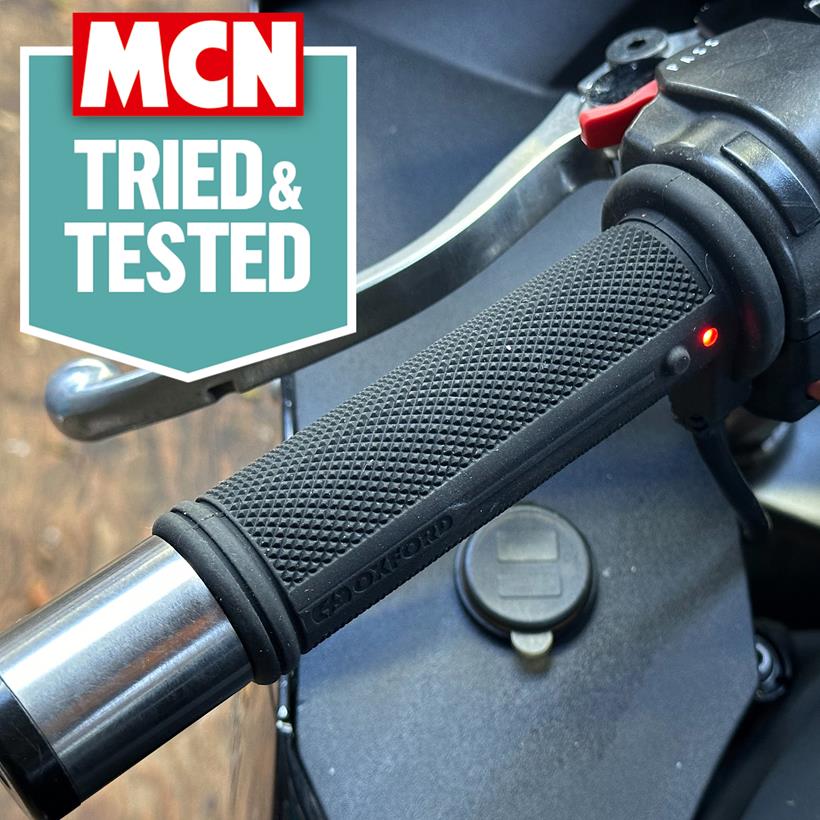

"Oxford’s HotGrips Pro provide effective and consistent heating whatever the conditions. They’re easy to fit, simple to use and look OE, plus the soft silicone grip surface makes them comfortable in use, even when they’re switched off.
"Performance so far has proved faultless, and, although not the cheapest on the market, I wouldn't have to think twice about spending my own money on them."
Read our full Oxford HotGrips Pro review
Pros
- Quick to warm up
- Three levels of effective heat
- Easy to fit
- Factory fitted look
- Battery saving mode
Cons
- Not cheap
- Integrated controller - allows rider to adjust temperature without removing their hand from the grip
- Built-in Thermistor technology auto-regulates temperature
- Precise temperature control - multi-coloured LED lights indicate temperature settings (Red = 45°C; White = 40°C; Blue = 35°C)
- LED lights automatically dim to reduce distraction when riding at night
- Intelligent heat setting memory - stores previous heat setting and defaults to this at power-up, saving time when in regular use. Note: Function is available when heat controller is connected to ignition
- Battery saving modes - protects against flat batteries, so if you forget to turn the switch off it will do it for you! An additional battery saving mode for lithium batteries
- Simple installation - the new integrated controller means that the HotGrips® wiring loom is even easier to install
- Silicone formed grips - increases grip lifespan by up to 200% without compromising comfort or performance
- Weatherproof design - fully waterproof connectors and integrated controller meet IP65 rating to protect your HotGrips® from the elements
- Integrated cable strain relief - a more compact cable exit enables grip size to be reduced
- Fits 7/8" (22mm) ⌀ handlebars
- Control guaranteed - knurling tread pattern creates the largest surface area for maximum of grip and control
- Customisable grips - Grip length of 125mm but can be trimmed to 120 or 115mm if required, with open ends allowing bar end weights can be fitted
Heated vests
Chances are your jacket already has some kind of thermal lining in place, but a heated vest will level up your winter riding experience significantly. Keeping the core of your body warm will help the warmth spread to the rest of your body, and makes a big difference on the coldest days. If heated gloves just aren’t cutting it, here are the best heated vests we’ve tested:
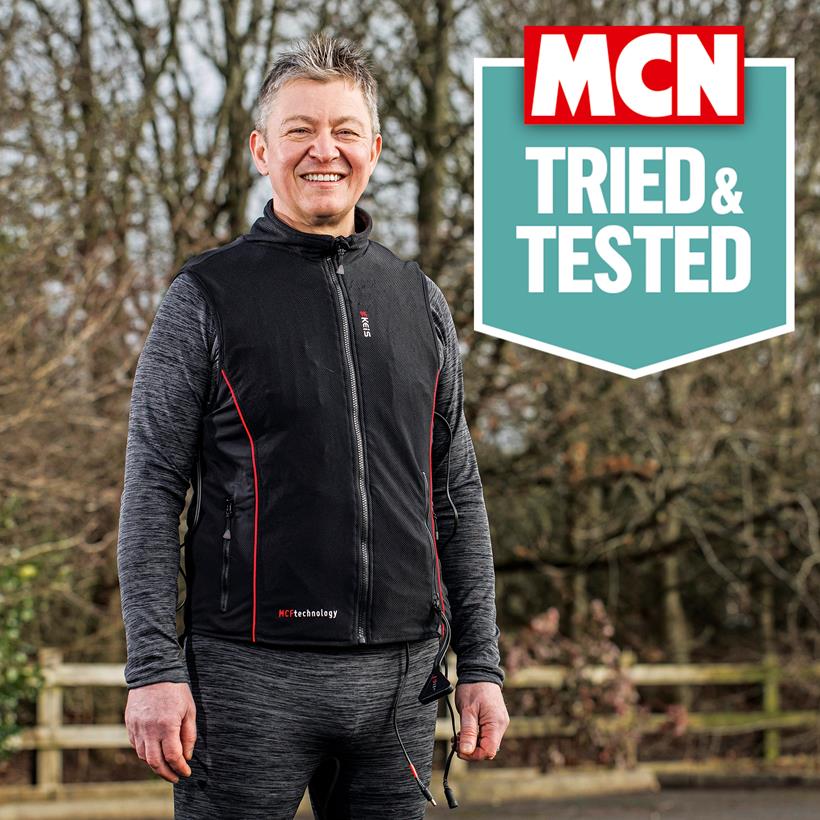

"Heated kit really does change the way you think about winter riding, and the Keis B601RP bodywarmer has proven itself essential as winter wear. It’s flexible, comfortable and produces more than enough heat to keep your core cosy. This is not only important for health, but also key for concentration, meaning you can give your full attention to the job in hand.
"I’d have to think long and hard about going out without it!"
Read our full Keis B601RP heated bodywarmer review
Pros
- Quick to warm up
- Easy to fit and simple to use
- Very comfortable to wear
- Good range of settings
Cons
- Waist level connectors an be annoying if you don't get them in the right place
| Heating | Micro carbon fibre |
| Outer | 85% Chinlon, 15% Spandex |
| Inner | 100% Polyester |
| Voltage | 12V |
| Current draw | 3.4A |
| Power | 41W |
| Sizes | 2XS to 3XL |
- Lightweight
- Breathable
- Moisture wicking


"This heated vest may not be the cheapest, but it’s light, comfortable and does a superb job of keeping me warm even in the depths of winter. It can either plug in to a bike’s battery, or you use the supplied 12v lithium battery, as I do when I’m road-testing different machines.
"It lasts three to four hours on a low setting and the vest is so efficient that the low and medium settings are all I ever need. Heat panels in the chest, lower back and back of the neck are regulated using sensors to check body temperature and you can scroll between the three heat levels via an illuminated button on the vest, or via Bluetooth with the Astars app."
Pros
- Warm and cosy
- Light and comfotable
- Lithium battery lasts a good three to four hours
Cons
- It isn't cheap
| Construction | Soft, stretch-polyester |
| Sizes | S–4XL |
| Type | Heated vest (battery and wired) |
| Weight | 500g |
- Automatic heating control, uses internal sensor to measure rider’s body heat
- On/off and heat controlled via illuminated button (with three pre-set settings) on vest, or via Alpinestars app.
- Plugs into your bike’s battery or supplied 12v lithium battery.
- Four heating panels: chest, lower back and back of neck.
- Asymmetric zip to reduce bulk when worn under layers.
- Zippable battery pocket
- Long back section for extra coverage when riding
- Reflective detailing
Heated seats
You never usually want to get caught in the hot seat, but you’ll make an exception for a heated motorcycle seat pad – and your rear end will thank you for it. For keeping winter chill at bay below deck, here’s our favourite heated motorcycle seats:
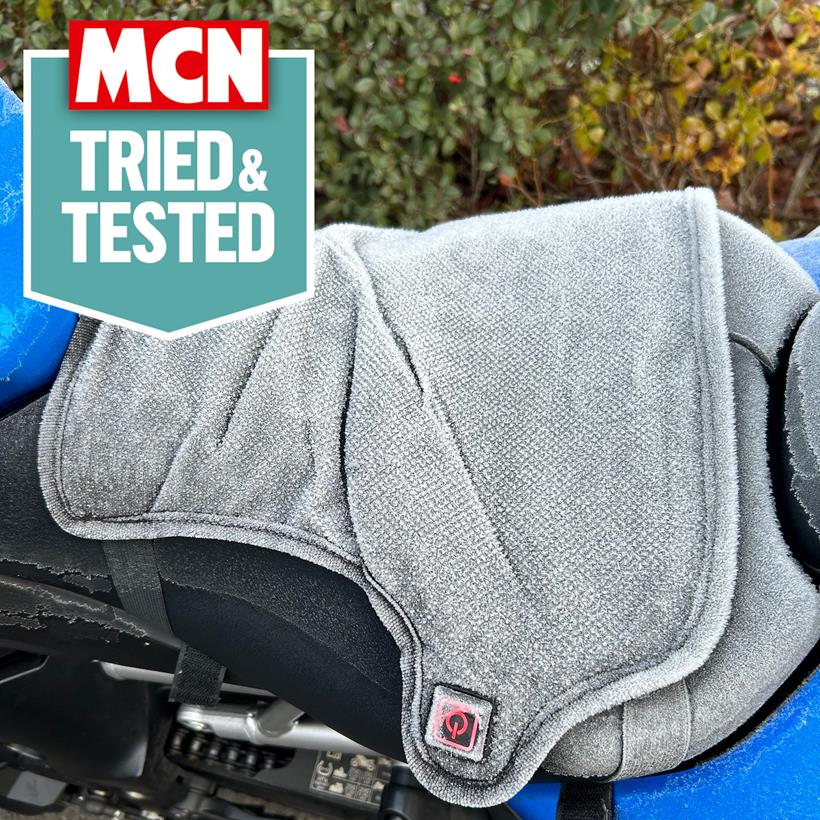

"Used in conjunction with a heated jacket and heated gloves the Oxford Hot Seat is a great addition to your winter riding set-up. It costs a very reasonable £79.99 and exceeded my expectations as to the level of heat and increased comfort it delivers. In fact the only thing to be aware of is with it being wired directly to the bikes battery you have to remember to turn it off when you stop riding to avoid a flat battery."
Read our Oxford Hot Seat first-ride review
Pros
- Very high level of heat on offer
Cons
- Doesn't turn itself off - could drain your bike's battery if you forget
- Heat output adjustable on the go
- Easy to install using hook & loop system
- 12w draw - at 12V input on 100% output
- Grippy material on top and bottom for secure hold
- Weatherproof construction and electronics
- Includes wiring loom
How MCN tests heated kit
Here at MCN, we make it our mission to help you find the right kit for you, at the right price for your budget. We test our heated kit the same way you’ll use yours, by braving the cold on our own bikes. And, we make sure to put them through at least 1000 miles of cold weather riding before sharing our findings. Our word is backed by hundreds of thousands of miles in the saddle collectively, but our recommendations come from each tester individually.
While testing, we mainly focus on comfort, looks, build quality, protection (if it’s relevant), and value. When we write up our full reviews, we’ll give each piece of heated kit a rating out of five stars in each of these categories, and offer a final verdict too. This page is only for the best riding heated kit, so every piece you’ll see has been awarded at least four stars overall – that’s the passing grade – but here’s what each score really means:
1 star – Poor performance in this category or overall. Heated kit with a single star rating has fallen below the expected standard and should be avoided.
2 stars – Basic performance in this area or overall. Heated kit with a two-star rating has managed to perform to a barely acceptable level, and there is much room for improvement.
3 stars – An average performance in this area or overall. Heated kit with a three-star rating has achieved a basic level of performance and is deemed adequate.
4 stars – Heated kit has performed over and above the accepted averaged in this category or overall. Heated kit with a four-star rating has surpassed expectation and delivered in a particularly impressive way.
5 stars – Heated kit has performed at the highest possible level in a particular category or overall. Heated kit with a five-star rating has delivered to the highest possible level, impressing the tester with its performance. We would happily spend our own money on it.
To find out more, head to our dedicated page explaining how we test motorcycle products.
- Just so you know, we may receive a commission or other compensation from the links on this website - read why you should trust us.





